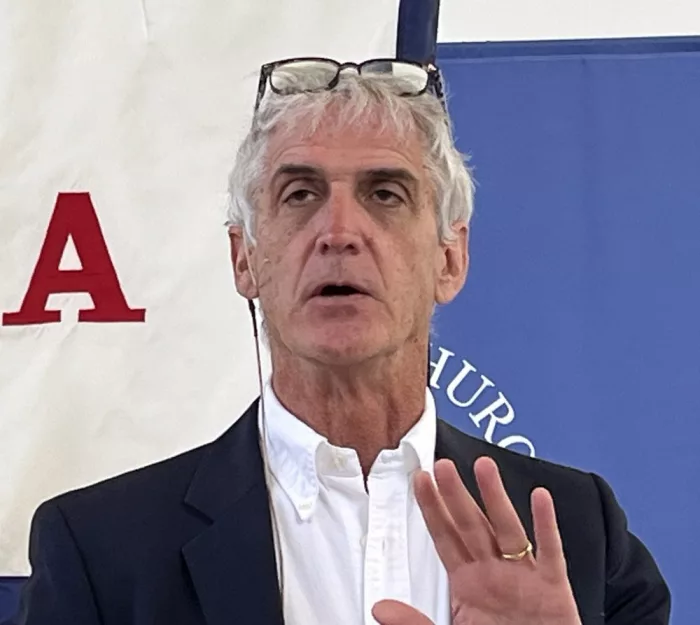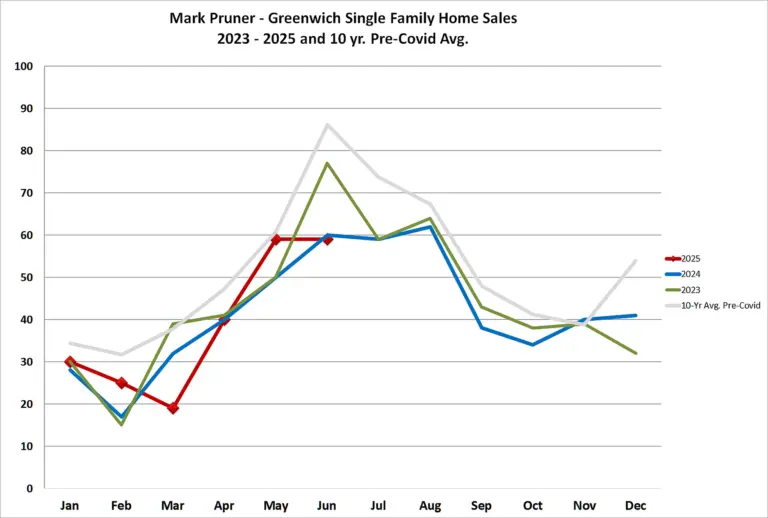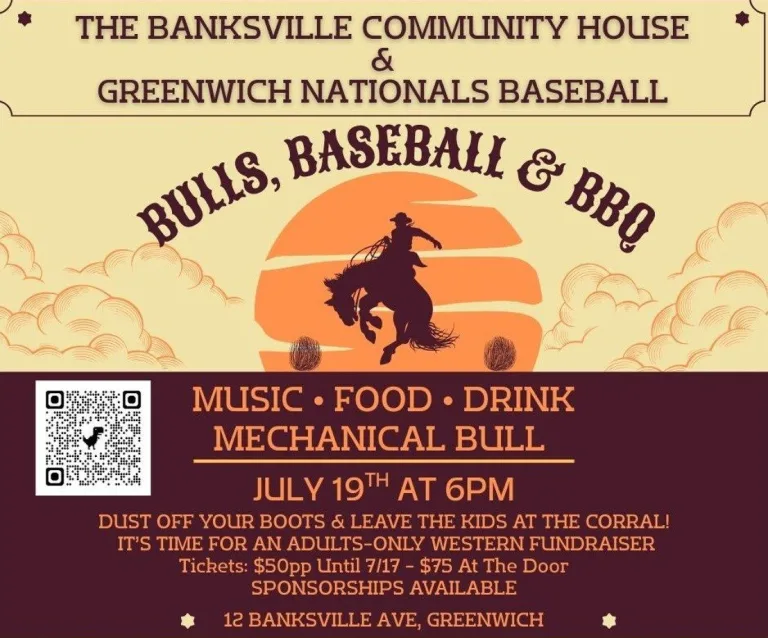
By Charlie Shapiro
At the April 2nd meeting of the Retired Men’s Association Bob Meaney introduced Greg Steinmetz, author of “American Rascal: How Jay Gould Built America’s Biggest Fortune.” Greg grew up outside Cleveland, graduated from Colgate, and earned a master’s at Northwestern. He spent 15 years as a newspaper reporter and editor, including London Bureau Chief of the Wall Street Journal. He then had a second career as a partner at a New York money management firm. His first book, about Jacob Fugger, another very wealthy man, appeared in 2015.
This book tells the fascinating story of how Jay Gould gained control of railroads, including the Union Pacific, and amassed a huge fortune. His estate in Tarrytown, Lyndhurst, is still standing. In a presentation that defied conventional wisdom, Steinmetz sought to re-evaluate the legacy of Gould, a figure often relegated to the shadows of better-known Gilded Age titans like Vanderbilt, Rockefeller, and Carnegie. The story was not simply a historical rehabilitation; it was a human-interest story, weaving together elements of tragedy, ambition, and the complex moral landscape of an era defined by unchecked capitalism.
Steinmetz began by quoting Mark Twain’s scathing indictment of Gould as “the mightiest disaster to ever have befallen this country.” But he questioned the judgment of Twain, living in luxury in Hartford after profiting from publishing President Grant’s memoirs. He contrasted Twain’s opulence with Gould’s image as a historical pariah, arguing that this was unjust, and cited Gould’s instrumental role in building the railroads that connected the nation.
The railroads made Gould one of the richest and most powerful people in the country, with ownership of 15% of the tracks. He was also the catalyst for the first rules governing finance and industry. Steinmetz lamented how Gould’s name, unlike that of his contemporaries, remained largely absent from prominent institutions and landmarks. He highlighted that while Rockefeller Center, Carnegie Hall, and Vanderbilt University stood as testaments to their respective benefactors, Gould was only remembered by a small auditorium. This was despite the fact that Gould was as rich as they were, or more. One reason is that in contrast to the others he died in his mid-50’s, in 1892. Thus, unlike the other robber barons, Gould died before being able to disburse his money in an act of philanthropy that would ensure his legacy.
Steinmetz highlighted Gould’s disadvantaged youth growing up in Roxbury, New York, where his alcoholic dad would lock him in the basement and forget about him. He also described Gould’s initiative to get rich and his passion for work. He taught himself to be a surveyor at 14 years old, making a map of Delaware county. The presentation moved on to an examination of Gould’s business schemes, starting with his plan to corner the gold market, leading to Black Friday and the stock exchange blowing up. Another caper was the “Erie Railroad Heist,” in which Gould positioned himself between Daniel Drew, the head of the Erie Railroad, and Cornelius Vanderbilt, who wanted to control it. Steinmetz argued that Gould’s actions, though often legally dubious by modern standards, were reflective of the “Wild West” atmosphere of Wall Street at the time, where insider trading and market manipulation were commonplace.
Steinmetz also described the flamboyant character of Jim Fisk, Gould’s associate in the gold market caper, who had formerly been a carny and traveling salesman. Fisk’s murder and funeral impacted Gould greatly. Also, Steinmetz touched upon Gould’s collaboration with Thomas Edison, seeking to disrupt Western Union’s dominance in the telegraph industry. This led into another tale of industrial sabotage and plans to break Western Union’s monopolies. Gould courted other rail companies to break their contracts with Western Union, and bought some smaller railroads to do the same. As a result, Western Union’s stock plunged, and he was able buy a majority share of Western Union, and ultimately negotiate Western Union’s takeover. Likewise, Steinmetz chronicled Gould’s acquisition of the Union Pacific Railroad. By buying rival railroads he was able to threaten Union Pacific, so they sold stock to him.
Steinmetz pointed out that the HBO show The Gilded Age has a character that was partly based on Gould. He showed a picture of where Gould lived on Fifth Avenue, and alluded to Gould’s passion for yachting and his creation of the American Yacht Club in Rye. Finally, Steinmetz concluded the tale of Gould’s life with a description of Gould’s unmarked, but large mausoleum in Woodlawn Cemetery. This mausoleum contrasted with others who had prominently named monuments. He showed a picture of Lyndhurst, the mansion where Gould lived in Tarrytown.
Steinmetz then took questions from the audience. Arnold Gordon asked about the role antisemitism played in Jay Gould’s life. Although he was portrayed as Jew in the press, in fact, he was Episcopalian. In the end, Steinmetz presented Gould as a figure who defied easy categorization, his legacy inextricably intertwined with the complexities and contradictions of the Gilded Age.
The talk can be viewed by going to the RMA website at https://greenwichrma.org, and clicking on “Speakers.”
The RMA’s upcoming presentation, “Nuclear Energy’s Place in Power Generation” by Seth Grae, is scheduled for 11 AM on Wednesday, April 16, 2025. Note: This and most future RMA presentations will be held at Christ Church Greenwich, Parish Hall, 254 E. Putnam Avenue, Greenwich, CT 06830.
Seth Grae, Chairman and Chief Executive Officer of Lightbridge Corporation (https://www.ltbridge.com/), will describe nuclear energy’s historical context and its current status, to include the remarkable performance of existing plants, next-generation nuclear technology, economic opportunities in the nuclear renaissance, the political and regulatory developments that are accelerating deployment, key market drivers (such as AI, data centers and security), and investment opportunities within the field.
Seth has been a member of the company’s Board of Directors since its formation in October 2006, He leads Lightbridge’s efforts to develop nuclear fuel technology to improve the safety, economics, and proliferation resistance of existing and new power reactors, including small modular reactors. Lightbridge’s proprietary fuel technology promises to make nuclear power—a reliable source of clean power—more competitive.
Seth is also chairman of the American Nuclear Society’s International Council and is a member of the World Economic Forum’s Advanced Energy Solutions Community. He is a member of the board of directors of the Nuclear Energy Institute. Seth is a frequent speaker about nuclear power at international conferences and at universities. He led Lightbridge’s advisory roles to governments of countries seeking to start or expand nuclear power programs, from feasibility studies through procurement and operations. Lightbridge developed the United Arab Emirates’ strategic plan for commercial nuclear energy. In volunteer roles through NGOs, Seth previously helped advise governments in drafting nuclear export control laws, including those of China and Belarus.
To stream the presentation by Seth Grae at 11 AM on Wednesday, April 16, click on https://bit.ly/30IBj21. This presentation will also be available on local public access TV channels, Verizon FIOS channel 24 and Optimum (Cablevision) channel 79. The public is also invited to attend the presentation in person at Christ Church Greenwich, Parish Hall, 254 E. Putnam Avenue.
Note: The views expressed in these presentations are those of the speakers. They are not intended to represent the views of the RMA or its members.
RMA speaker presentations are presented as a community service at no cost to in-person or Zoom attendees, regardless of gender. Any member of the public who would like to receive a weekly email announcement of future speakers should send a request to members@greenwichrma.org. The RMA urges all eligible individuals to consider becoming a member of our great organization, and thereby enjoy all the available fellowship, volunteer, and community service opportunities which the RMA offers to its members. For further information, go to https://greenwichrma.org/, or contact info@greenwichrma.org.





